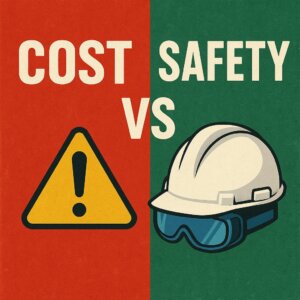In high-risk sectors such as petrochemicals, power maintenance, and fire rescue, static sparks or sudden flames can trigger catastrophic accidents. Flame-resistant anti-static clothing (FR/AS), as specialized protective gear, integrates flame resistance and static control, serving as “technological armor” for frontline workers. This article explores its technical principles, core performance, and selection criteria.
1. Dual Protection: Principles & Technological Breakthroughs
FR/AS clothing achieves protection through two core technologies:
- Flame Resistance: Fabrics form a dense carbonized layer when exposed to fire, isolating oxygen and breaking combustion chain reactions (self-extinguishing within 2 seconds after flame removal) .
- Anti-Static Properties: Embedded conductive fibers (e.g., carbon or metal wires) create charge-dissipation pathways, reducing human-body static to safe levels (surface resistance typically maintained at 10⁶–10⁹ Ω)
Traditional methods faced functional conflicts: Flame-retardant coatings weakened anti-static efficacy and caused fabric hardening. Modern solutions use inherently flame-resistant fibers + conductive fiber blends (e.g., aramid-conductive yarns), balancing protection and comfort .
2. Fabric Comparison: Performance vs. Cost Trade-offs
Different materials suit varied scenarios, with key differences summarized below:
| Fabric Type | Composition | Flame Treatment | Anti-Static Method | Pros | Cons |
|---|---|---|---|---|---|
| Treated Cotton | 100% Cotton | CP/THPC Finish | Conductive Fiber Weaving | Low cost, breathable | Stiff feel, poor wash durability (≈20 cycles) |
| CVC Blend | 80% Cotton + 20% Polyester | THPC Finish | Conductive Fiber Weaving | Cost-effective | Melting polyester may cause secondary burns |
| Aramid Blend | 93% Meta-Aramid + 5% Para-Aramid + 2% Conductive Fiber | Inherent FR | Conductive Fiber | Permanent FR, 1000°C resistance, lightweight | High cost (≈3× standard fabrics) |
| Modacrylic-Cotton | 60% Modacrylic + 38% Cotton + 2% Conductive Fiber | Inherent FR | Conductive Fiber | Soft texture, low formaldehyde | Moderate flame resistance |
Note: Aramid fabrics (e.g., Kevlar, Nomex) retain protection after washing and are preferred in nuclear/aviation industries due to inherent non-flammability .
3. Key Performance Metrics: Industry Standards
Certified FR/AS garments must comply with multiple tests (per GB 8965.1-2020, GB 12014, ASTM F1506 ):
- Flame Resistance: After-flame time ≤2 sec, smoldering ≤5 sec, char length ≤150 mm;
- Static Control: Surface resistance 10⁵–10¹¹ Ω, charge decay <0.5 sec;
- Durability: ≤10% performance loss after 50 industrial washes;
- Safety: Formaldehyde ≤75 mg/kg, no carcinogenic dyes or odors

EU standards (PPE Regulation EU 2016/425) additionally require full-body manikin testing: Simulated second-degree burns must cover <25% of body surface .
4. Selection Guide: Scenario Adaptation & Critical Details
-
Match Fabric to Risk Level
- Moderate Risk (e.g., warehouses, machining): CVC blends balance cost and protection.
- High Hazard (welding, oil fields, chemical plants): Prioritize aramid-based fabrics for permanent safety .
-
Design Details Ensure Safety
- Seam Structure: Double-stitching with FR threads (e.g., aramid yarns) prevents seam failure at high temperatures .
- Compatible Accessories: Metal zippers require FR lining to block heat transfer; reflective strips need FR certification.
- Grounding Design: Cuffs/ankles must include conductive ribbing for static dissipation
-
Maintenance & Lifespan
- Wash at ≤70°C; avoid chlorine bleach (damages conductive fibers).
- Aramid lifespan: ≈3 years; treated cotton: ≈1 year
5. Emerging Trends: Smarter & Greener Solutions
- Self-Regulating Fabrics: Phase-change material (PCM) coatings absorb heat to delay burns .
- Bio-Based Flame Retardants: Replace halogenated compounds (e.g., BASF EcoFlam®) to reduce toxicity .
- Wearable Sensors: Embedded optical fibers monitor real-time temperature/arc-flash risks .
Conclusion
FR/AS clothing has evolved from basic workwear to a precision system integrating materials science, textile engineering, and safety technology. In hazardous environments, it is not merely a compliance requirement but a lifeline. As smart materials advance, future protective gear will function like a “second skin”—silent yet indestructible.








